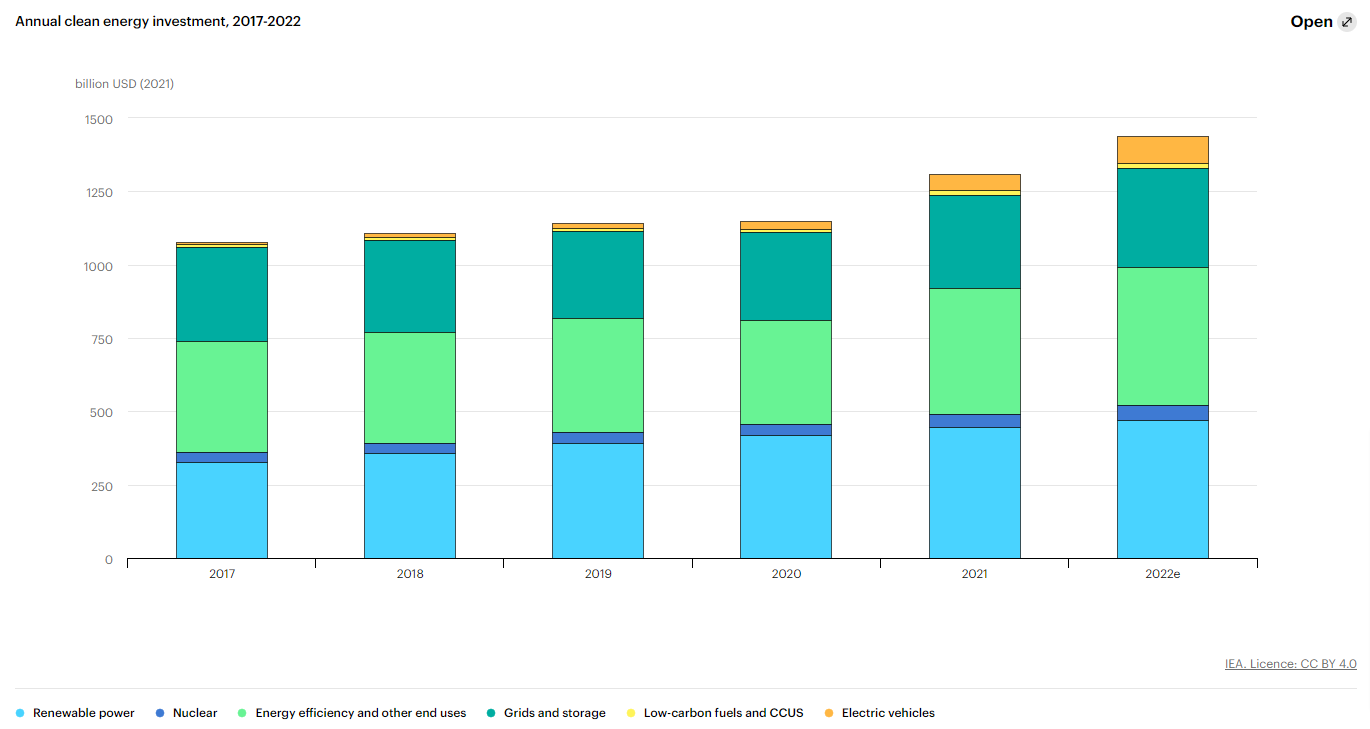In the face of escalating climate change and the urgent need to reduce carbon emissions, the world is increasingly turning towards sustainable energy solutions. The transition from traditional fossil fuels to renewable energy sources is not just an environmental imperative, but also a financial one. The affordability of sustainable energy in the long term is a topic of paramount importance to everyone, from newly married couples and new homeowners to environmental enthusiasts and policymakers.
The concept of sustainable energy encompasses energy sources that are not only renewable but also have minimal impact on the environment. This includes solar power, wind energy, hydropower, and geothermal energy, among others. The transition to these energy sources is often seen as a costly endeavor. However, when we consider the long-term benefits and savings, the picture begins to change.
This blog post will delve into the economics of sustainable energy, exploring how advancements in technology, policy support, and market trends are making renewable energy increasingly affordable. We will examine the cost dynamics of sustainable energy, the role of investment and finance in driving down these costs, and the long-term economic and environmental benefits of this energy transition.
The goal is to provide a comprehensive understanding of why sustainable energy is not just a viable option for the future, but also an economically sound choice. So, whether you’re a young adult considering your energy options, an environmentalist advocating for cleaner energy, or a policymaker looking to understand the financial implications of the energy transition, this blog post is for you.
Key Takeaways
- The cost of sustainable energy has been falling rapidly, making it increasingly affordable.
- Investment and policy support plays a significant role in driving down the costs of sustainable energy.
- Technological advancements and efficiency improvements are key to reducing the cost of sustainable energy.
- The transition to sustainable energy brings significant environmental benefits, including reduced emissions and conservation of natural resources.
- The future of sustainable energy is promising, with ongoing technological advancements, supportive policies, and increasing societal awareness.
- Denmark’s successful transition to affordable sustainable energy serves as a powerful example for other countries and communities.
The Affordability of Sustainable Energy
When discussing the affordability of sustainable energy, it’s crucial to understand the factors that contribute to its cost. The initial investment required for setting up infrastructure like solar panels or wind turbines is often cited as a significant barrier. However, it’s essential to consider that these are one-time costs, and the long-term savings can be substantial.
Free ‘Fuel’ and Lower Ongoing Costs
Unlike fossil fuels, the ‘fuel’ for renewable energy – be it sunlight, wind, or water – is free. Once the infrastructure is in place, the ongoing costs are primarily maintenance and potential upgrades. This contrasts with the continuous costs associated with extracting, refining, and transporting fossil fuels.
Decreasing Costs of Renewable Technologies
The cost of renewable energy technologies has been falling rapidly. For instance, the cost of solar power fell by 85% between 2010 and 2020, while onshore and offshore wind energy costs fell by 56% and 48%, respectively. This trend is expected to continue as technology advances and economies of scale come into play.
Stability and Incentives
Moreover, renewable energy sources are not subject to the price volatility often seen with fossil fuels. They provide a stable, predictable price, which can be particularly beneficial for homeowners and businesses looking to manage their long-term energy costs. Additionally, there are numerous incentives and subsidies available for renewable energy, from tax credits to feed-in tariffs. These can significantly offset the initial investment and make renewable energy a more affordable option.
While the upfront costs of sustainable energy can be higher than traditional energy sources, the long-term costs are often lower. When we factor in the environmental benefits and the potential savings from reduced healthcare costs due to cleaner air, the case for the affordability of sustainable energy becomes even stronger.
The Long-term Economic Benefits of Sustainable Energy
The economic benefits of sustainable energy extend far beyond the cost savings on energy bills. These benefits permeate various sectors of the economy, creating a ripple effect that leads to overall economic growth and stability.
Job Creation
One of the most direct economic benefits of sustainable energy is job creation. The renewable energy sector is labor-intensive and creates more jobs per unit of energy produced compared to fossil fuel-based energy. These jobs range from manufacturing and installation to maintenance and operations, providing employment opportunities across various skill levels.
Energy Independence
Sustainable energy also contributes to energy independence. By reducing reliance on imported fossil fuels, countries can achieve greater energy security, stabilize energy prices, and insulate their economies from the volatility of international fossil fuel markets.
Health and Environmental Savings
Transitioning to sustainable energy also leads to significant health and environmental savings. By reducing air and water pollution, we can decrease healthcare costs and increase productivity, as fewer people suffer from pollution-related illnesses. Moreover, mitigating climate change can prevent the substantial economic damages associated with extreme weather events and rising sea levels.
Stimulating Innovation and Technological Advancement
Investment in sustainable energy can stimulate innovation and technological advancement. The need for more efficient and cost-effective renewable energy technologies drives research and development, leading to technological breakthroughs that can have broad economic benefits.
Investment in Sustainable Energy
Investment plays a crucial role in the affordability and adoption of sustainable energy. It is the driving force behind research and development, infrastructure development, and the overall growth of the renewable energy sector.
Current State of Investment
Currently, as the economic and environmental benefits of renewable energy become more apparent. Governments, private companies, and individuals are increasingly investing in renewable energy projects.

Role of Investment in Affordability
Investment directly impacts the affordability of sustainable energy. Increased investment leads to advancements in technology and infrastructure, which in turn leads to cost reductions. Moreover, as more investments are made in renewable energy, economies of scale come into play, further driving down costs.
Case Studies of Successful Investments
There are numerous examples of successful investments in renewable energy that have led to significant cost reductions. For instance, the large-scale investment in solar power in countries like Germany and China has led to a dramatic decrease in the cost of solar panels. Similarly, investment in wind energy in countries like Denmark and the US has made wind power one of the most cost-effective sources of electricity.
Policy and Market Influence on Sustainable Energy Cost
The cost and affordability of sustainable energy are not solely determined by technological advancements and investments. They are also significantly influenced by policy decisions and market trends.
Role of Government Policies
Government policies play a crucial role in shaping the cost dynamics of sustainable energy. Policies such as renewable portfolio standards, feed-in tariffs, tax credits, and subsidies can make renewable energy more competitive with traditional energy sources. Additionally, policies aimed at internalizing the environmental costs of fossil fuels, such as carbon pricing, can further level the playing field.
Impact of Market Trends
Market trends also have a significant impact on the cost of sustainable energy. As the demand for renewable energy increases, economies of scale come into play, leading to cost reductions. Moreover, as societal awareness and demand for clean energy grow, it can drive further investment in the sector, leading to technological advancements and cost reductions.
The Interplay of Policy and Market
The interplay between policy and market trends can create a virtuous cycle. Supportive policies can stimulate the market, leading to increased demand, which in turn drives down costs. As costs decrease, renewable energy becomes more competitive, leading to further market growth and policy support.
Technological Advancements and Efficiency
Technological advancements and efficiency improvements are key drivers in reducing the cost of sustainable energy and making it more affordable for consumers.
Role of Technology in Sustainable Energy
Technology plays a pivotal role in every aspect of sustainable energy, from the efficiency of solar panels and wind turbines to the development of energy storage solutions. As technology advances, we are able to harness renewable energy sources more effectively and efficiently, which directly translates into cost reductions.
Efficiency Improvements
Efficiency is a crucial factor in the cost of sustainable energy. The more efficiently we can convert renewable resources into usable energy, the lower the cost. Over the past few decades, there have been significant efficiency improvements in renewable energy technologies. For instance, the efficiency of solar panels has more than doubled, and wind turbine technology has also seen substantial efficiency gains.
Future Technological Advancements
Looking to the future, ongoing technological advancements hold the promise of further cost reductions. Emerging technologies, such as perovskite solar cells and floating wind turbines, have the potential to revolutionize the renewable energy sector and make sustainable energy even more affordable.
Environmental Impact of Sustainable Energy
The transition to sustainable energy is not just about cost and economic benefits. It’s also about creating a healthier, more sustainable environment for future generations.
Reduced Emissions
One of the most significant environmental benefits of sustainable energy is the reduction in greenhouse gas emissions. Unlike fossil fuels, renewable energy sources produce little to no emissions during operation. This helps mitigate climate change and reduces the health risks associated with air pollution.
Conservation of Resources
Sustainable energy also helps conserve our natural resources. Fossil fuels are finite resources that will eventually run out, whereas renewable energy sources like the sun and wind are virtually inexhaustible. By transitioning to sustainable energy, we can ensure a reliable energy supply for future generations.
Minimal Environmental Impact
In addition to reducing emissions and conserving resources, sustainable energy also has a minimal impact on the environment. The extraction and use of fossil fuels can lead to oil spills, water pollution, and habitat destruction. In contrast, renewable energy sources have a much smaller environmental footprint.
The Future of Sustainable Energy
As we look toward the future, the prospects for sustainable energy are promising. With ongoing technological advancements, supportive policies, and increasing societal awareness, sustainable energy is set to become more affordable and widely adopted.
Future Cost Predictions
The cost of sustainable energy is expected to continue falling in the future. As technology continues to advance and economies of scale are realized, renewable energy is likely to become even more cost-competitive with traditional energy sources. Some studies even predict that by 2030, it will be cheaper to build new renewable energy infrastructure than to continue operating existing fossil fuel plants.
Impact on the Economy, Environment, and Society
The transition to sustainable energy will have far-reaching impacts on our economy, environment, and society. It will create jobs, stimulate economic growth, reduce emissions, and improve air quality. Moreover, it will make energy more accessible and affordable, particularly for those in remote or disadvantaged communities.
The Role of Individuals and Communities
The transition to sustainable energy is not just about governments and corporations. Individuals and communities also have a crucial role to play. By adopting renewable energy solutions, advocating for supportive policies, and making sustainable choices, we can all contribute to a more affordable and sustainable energy future.
Successful Transition to Affordable Sustainable Energy
To better understand the potential of sustainable energy, let’s look at a real-world example. Denmark, a small country in Northern Europe, has been a pioneer in the transition to renewable energy and offers valuable insights into how sustainable energy can be both affordable and practical.
Denmark’s Energy Transition
Denmark began its energy transition in the 1970s in response to the oil crisis. Over the years, the country has implemented a range of policies to support renewable energy, including feed-in tariffs, tax incentives, and renewable portfolio standards. Today, Denmark gets over half of its electricity from wind and solar power and aims to be carbon-neutral by 2050.

Impact on Energy Costs
Despite the significant investment in renewable energy, electricity prices in Denmark have remained competitive with other European countries. This is due in part to the falling costs of wind and solar power, as well as the efficiency gains from a highly integrated and flexible energy system.
Broader Economic and Environmental Benefits
The transition to renewable energy has also brought broader economic and environmental benefits. Denmark has become a global leader in wind turbine manufacturing, creating thousands of jobs. The country has also seen significant reductions in greenhouse gas emissions and improvements in air quality.
Conclusion
The affordability of sustainable energy in the long term is a multifaceted issue that encompasses technological advancements, policy support, market trends, and societal awareness. While the initial costs of transitioning to sustainable energy can be high, the long-term benefits – both economic and environmental – are substantial.
We’ve seen how the cost of renewable energy technologies has been falling rapidly, making sustainable energy increasingly affordable. We’ve also explored the significant role of investment and policy support in driving down these costs. Furthermore, we’ve highlighted the long-term economic benefits of sustainable energy, including job creation, energy independence, health savings, and technological advancement.
The case study of Denmark serves as a powerful example of a successful transition to affordable sustainable energy. It demonstrates that with the right policies and investments, sustainable energy can be not just an environmentally responsible choice, but also an economically sound one.
As we look to the future, the prospects for sustainable energy are promising. With ongoing technological advancements, supportive policies, and increasing societal awareness, sustainable energy is set to become more affordable and widely adopted.
Whether you’re a young adult considering your energy options, an environmentalist advocating for cleaner energy, or a policy maker looking to understand the financial implications of the energy transition, we hope this blog post has provided you with a comprehensive understanding of the affordability of sustainable energy in the long term. The transition to sustainable energy is not just a necessity for our planet, but also a viable and economically sound choice for our future.
Frequently Asked Questions (FAQs)
-
What is long-term sustainable energy?
Long-term sustainable energy refers to energy sources that are renewable and can meet our energy needs indefinitely without causing significant harm to the environment or future generations.
-
Is renewable energy cheaper in the long term?
Yes, while the initial setup costs for renewable energy systems can be high, the long-term costs are often lower. This is because renewable energy sources like wind and solar do not require fuel costs and have lower maintenance costs.
-
How affordable is renewable energy?
The affordability of renewable energy has improved significantly in recent years due to technological advancements, economies of scale, and supportive policies. Today, in many parts of the world, renewable energy is cost-competitive with traditional energy sources.
-
Is renewable energy sustainable in the long term?
Yes, renewable energy is considered sustainable in the long term as it relies on resources that are naturally replenished, such as sunlight, wind, and water. Moreover, renewable energy technologies have a smaller environmental footprint compared to traditional energy sources.

